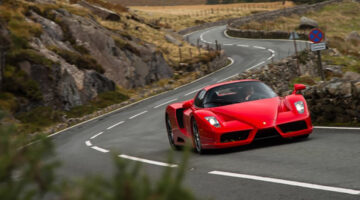Its rarity and beauty sees this ’60s Japanese classic much sought‑after by collectors, but it turns out it’s a peach to drive, too
To have been a fly on the wall in a stuffy boardroom in Aichi, Japan, sometime in the early 1960s. To have overheard as board members discussed a proposal from inspired minds at Yamaha for a sleek and exotic new sports car, dramatically different from the meek saloons Toyota was beginning to export across the globe. Decisions made that day have resulted in one of the rarest, most exquisite and most valuable cars ever to have come out of Japan.
It’s a car that, today, photographer Aston Parrott is giggling about as he balances precariously on the rear parcel shelf in the one spot deemed by Toyota’s nervous minder as appropriate for a human adult to perch in order to take a photograph of me driving. This is probably not what Toyota’s engineers had in mind for their petite two-seat sports car, nor its current keepers at Toyota Europe.
> Aston Martin DB4: review, history and specs
They have two, in fact, which is why you’ll see two different number plates in these images. Toyota Europe acquired them both to complete its collection of rare Toyota vehicles, many of which were bought wholesale from the collection of a German dealer and enthusiast when he passed away several years ago. The gentleman in question had spent most of his life offering canny deals on new cars when customers came in with pristine older examples, and swayed by shiny Corollas and Camrys, the owners had happily handed over the keys to their Crowns and Coronas. Almost all of them are red, which is handy given it’s Toyota’s corporate colour.
This little corner of the Rhine Valley probably has the highest concentration of 2000GTs anywhere in the world right now as a result. Just 351 were built, between 1967 and 1970, and it’s likely that fewer still survive, the remaining cars occasionally rolling through auctions and leaving with new owners and large six-figure sums against their chassis numbers. The last, in December 2018, traded hands for $511,000. In 2014, two examples crossed the block at more than a million dollars apiece. It’s appropriate that the only other Japanese car to have achieved similar numbers is the Lexus LFA – another Toyota product, and another boasting Yamaha expertise behind the scenes.
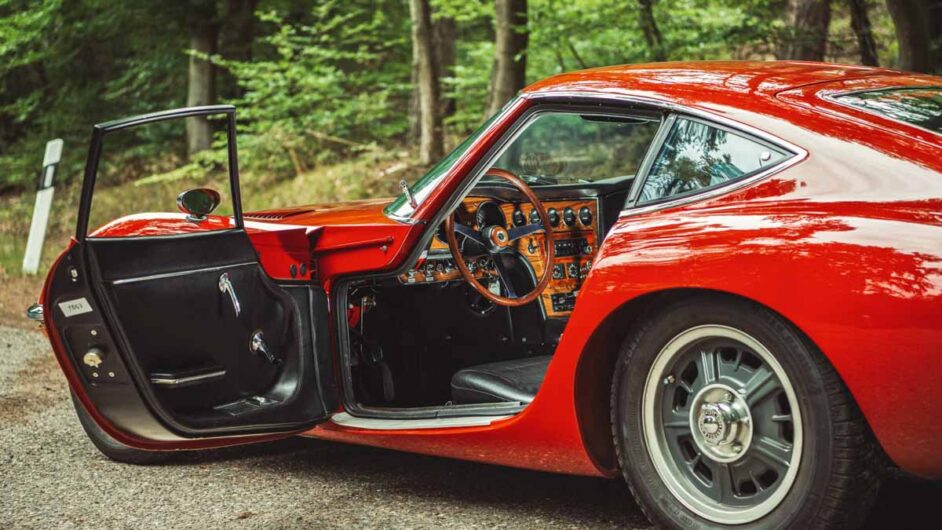
When the LFA arrived in 2010, though, the world was well aware of what Japanese companies were capable of. The 2000GT was conceived at a rather different time, the industry still recovering from post-war recession. Many Japanese cars in the early 1960s were licensed from other countries or were at least echoes of those built elsewhere. Where they differed was in the adoption of technology, with twin-cam cylinder heads and sophisticated suspension set-ups not uncommon even in humble vehicles. They were admired for this, but rarely coveted.
For Toyota, the 2000GT would explore not just new technology but an entire segment new to Japanese manufacturers: a luxury grand tourer. Work began in 1963, led by Toyota’s then chief engineer Jiro Kawano. A two-seat layout was chosen over the increasingly popular 2+2, which today seems a wise choice given the requirement to fit two Western-sized occupants in such a petite frame. At 4175mm long, the 2000GT was just under a foot shorter than an E-type, as well as a couple of inches narrower and a striking two-and-a-half inches lower.
If you could peel away that pretty Satoru Nozaki-designed bodywork, you’d see Western influence creeping in: an extended X-shaped central spine carrying the engine, transmission and differential, with double-wishbone suspension attached to each corner – not unlike that of contemporary Lotus models such as the Elan, and more sophisticated than that of the E-type, to which the 2000GT is often compared.
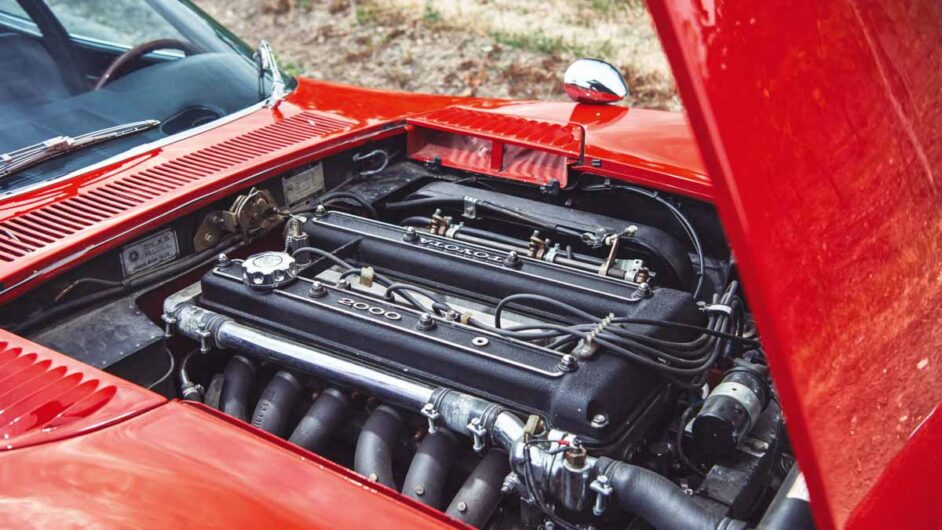
The engine’s origins were humble, derived from a 2-litre in-line six used in the Toyota Crown saloon. It featured an aluminium Yamaha-designed head in this new application, however, with two chain-driven cams. Aspiration was by a trio of Mikuni-Solex twin-choke carburettors, two valves per cylinder, an 8.4:1 compression ratio and a pair of free-breathing three-branch exhaust manifolds, the end result enough for a 148bhp maximum at a free-spinning 6600rpm. Torque was modest at 130lb ft, and accessed high at 5000rpm, but was ably handled by a fully synchromesh five-speed manual transmission and standard limited-slip differential.
Sophistication continued with disc brakes at all four wheels, a high-geared rack-and-pinion steering set-up with only 2.67 turns lock to lock, and magnesium alloy wheels to minimise unsprung mass at a time when, once again, E-types were still using wire wheels with knock-off centres.
E-type comparisons are inevitable, but in the cool morning of a Rhine Valley forest, the 2000GT has its own personality. Both are low and swept back, more bonnet than cabin, but the Toyota’s windscreen is more steeply raked, and thanks to larger wheelarches the Japanese car has less visual mass over its tyres. The proportions are clearly similar, but the GT’s details are for me more intriguing, from the faired-in driving lights either side of the grille, to the exotic quartet of circular rear lamps, and the sharp ridges over the front wings that clearly demarcate where the plan view stops and the profile begins.

Choosing a best angle is like selecting your favourite family member, but if you were to crouch low, perhaps 20 feet away from the side of the car, you’d struggle to find a sleeker, more dainty profile this side of a contemporary Grand Prix car. Something you’ll notice from this vantage point is just how long the doors look, until you pace a few steps closer and realise that this is only in proportion to the rest of the car. The cut-out is as far forward as the leading edge of the windscreen, a detail necessary simply to fit your legs through the aperture as you feed into the tiny cockpit.
It is, however, quite comfortable once inside. Find an elegant way in and the cabin should accommodate longer legs quite easily, but if you’re over six feet things might begin to get cramped, particularly for those taller of torso. One of those was Sean Connery, whose 6ft 2in frame was accommodated simply by cutting off the roof of the car that featured in 1967’s You Only Live Twice. The result was at least more convincing than Connery’s Japanese make-up later in the movie, but it wouldn’t be until the Datsun 240Z that Japan would create a sports car truly built for European and American physiques.
Glancing through the low-set side windows is tricky even for me, but the forward visibility is glorious. I’ve never driven a Stratos, but I imagine the view through the curve of glass would be similarly panoramic, and the Italian wouldn’t give you that long metal landscape stretching ahead, nor have two small mirrors perched upon its extremities. These offer a better view backwards than you might expect, but you’d need your driving companion to climb out and adjust them.
Our chosen stretch of smooth forest road is quiet, but the silence doesn’t last long. The start-up sequence of older cars is often a joy, particularly ones as well-tuned as this Toyota, which needs little geeing-up to fire. Twist the key to rouse the fuel pump, a couple of short, meaningful prods of the throttle pedal to prime the Mikunis, and a final twist ignites the six in just a few turns of the crank.
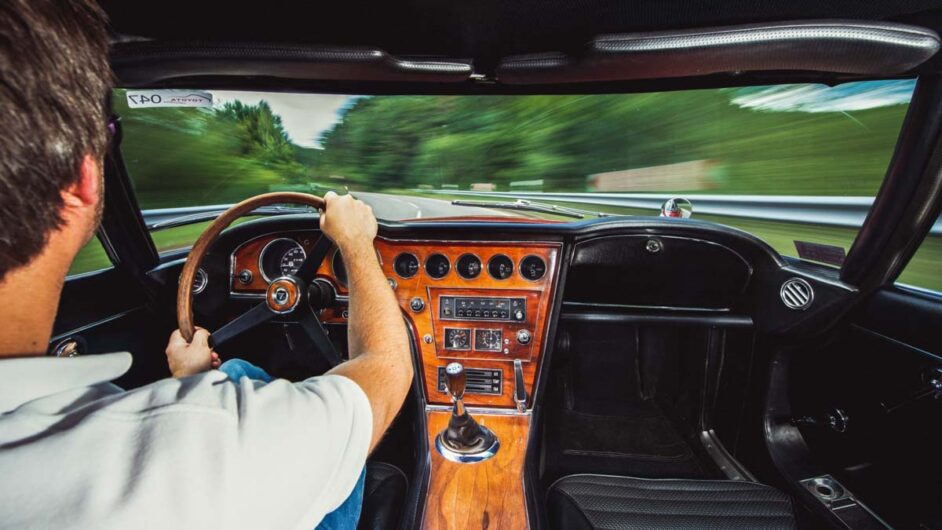
The soundtrack is much less sophisticated than you might expect of a small-capacity in-line six, but it settles after only a few minutes of choke. Encouraging the thousand-rpm tickover with regular small presses of the slim, low-mounted right-hand pedal releases gruff gaaaarums through the twin exhausts, but surprisingly little vibration fizzes through the frame.
The 2000GT’s dashboard is a mix of period vinyl and plastic and large, flat slabs of rosewood. It’s punctuated left to right in this left-hand-drive car by the inset speedometer and tachometer – the latter daubed in red after 7000rpm, but marked up to an optimistic 9000rpm – and then a quintet of gauges, their flickering and bouncing needles indicating battery current, water and oil temperatures, oil pressure, and remaining fuel.
Below is a radio unit, and below that two more dials – a clock and stopwatch – with fresh-air controls and the umbrella-handle handbrake to the right of those. Where the gearlever sits is sparse; I’ve been resting my phone there, but as both the daytime temperature rises and the transmission heat-soaks, it’s getting perilously hot. But if the console is empty, the rest of the dash is anything but – ergonomics have come a long way since a bank of switches below the steering column was considered acceptable. Little toggles have been applied by blunderbuss, with everything from the indicators to the electrically powered pop-up headlights activated by the same style of switch.
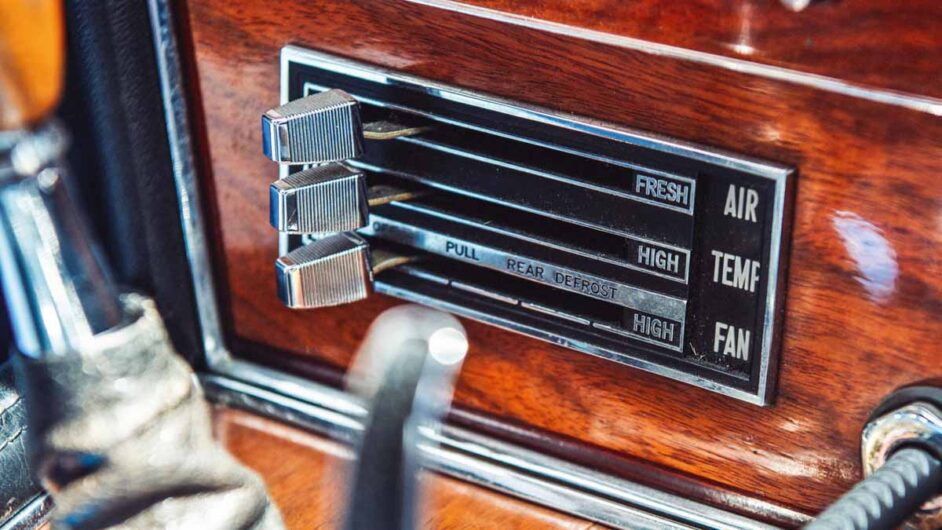
The major controls, though, show Toyota understood quality and precision even in the 1960s. The clutch has some heft but an easy action, and there’s a short mechanical click as the wooden-topped lever slots into first. There’s another growl from the tailpipes and a chuff from the Mikunis as I feed in enough throttle to pull away, but with only 1120kg to carry, the 2-litre six feels torquier than you’d infer from the figures alone. First is quite short, but the 2000GT moves away smartly as a result, just requiring a few more revs before you nip the lever back to second.
There’s little slack to be found. Moving the wheel has an almost instant effect, despite your relative distance to the front wheels. The quick rack helps here, but the action itself is tight and direct. Lean against the rim, even just off-centre, and the nose follows, and while you’d expect this to lead to some high-speed nerviness, it never materialises. Many older cars let you know you’re travelling quickly with a wobble or a wander, but the 2000GT tracks true.
This must have made it ideal in October 1966, when Toyota took a pair of yellow and green 2000GTs to the Yatabe proving ground in Japan. It returned with more than a dozen speed and endurance records, among them a 207kph average lap on the large, banked circuit. The cars weren’t standard, but weren’t built to full, 200bhp competition specification either, so the records served as an early demonstration of the road car’s performance, stability and durability.
I’d been curious how the car was received in its era, and journalists from both the Car and America’s Road & Track praised the GT’s responses in their 1966 and 1967 tests. Both publications also noted a neutral feel to the chassis, with neither excesses of understeer nor oversteer, while the low chassis and relatively wide track meant little pitch or roll from the suspension but also pliant straight-line characteristics. Each writer too praised the visibility, but only for those who managed to fit, and while it took Brits to draw comparison with the E-type, the Americans made the more astute observation that both its price and talent level put it squarely into Porsche 911 territory – albeit with a character all its own.
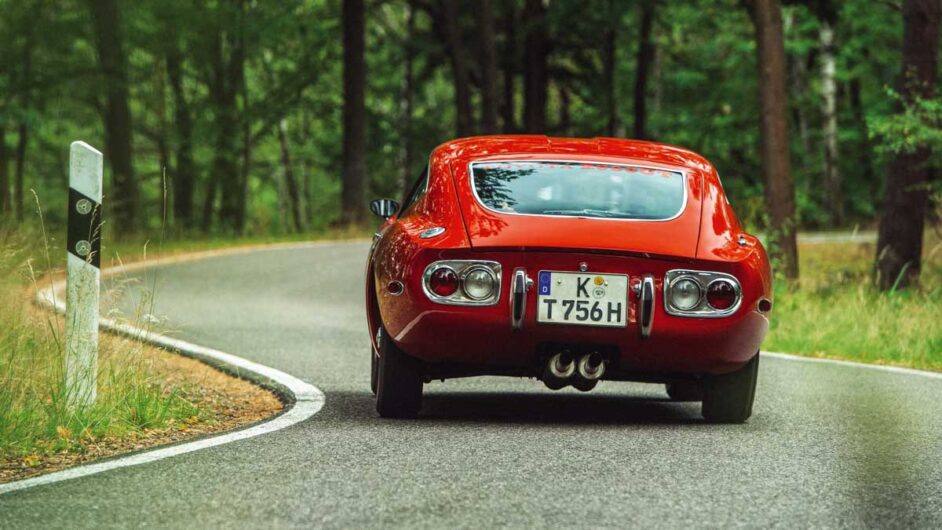
And that character remains strong to this today. With limited time for photography, Aston and I had planned ahead and borrowed a charming AE86 Corolla to scout the road beforehand. Tackling the same stretch in the GT a few hours later, the older car defies its years, besting the ’80s drifting icon in everything from performance and precision to build quality and body control. As a grand tourer, the 2000GT has a wonderful, long-legged feel, each gear stretching higher than you’d expect but not so yawning that you don’t get to enjoy a few different ratios on a road like this, with its extended straights and gentle radii between slower, twistier sections.
The engine’s response feels keen and its willingness to rev perfectly in tune with the throttle pedal’s travel. Ask too much too early and the carbs stutter and hesitate, but let the butterflies breathe and the cabin fills with a racer’s rasp. I can only enjoy it from inside, but I’m told it’s also rather fabulous as you listen to it disappear around a distant corner in a forest, scattering wildlife with every parp of the slim exhausts.
The engine is, thankfully, matched by the brakes. Testers at Road & Track recorded 0.84 G of deceleration from 128kph back in ’67, which is probably bettered by a Yaris today, but, more pertinently, it proved repeatable during their road testing. In deference to the car’s age and value I keep today’s hard braking to a minimum, but the firm pedal and apparent lack of fade breeds confidence into hairpins, and acts as a fine pivot to blip the throttle on each downchange.
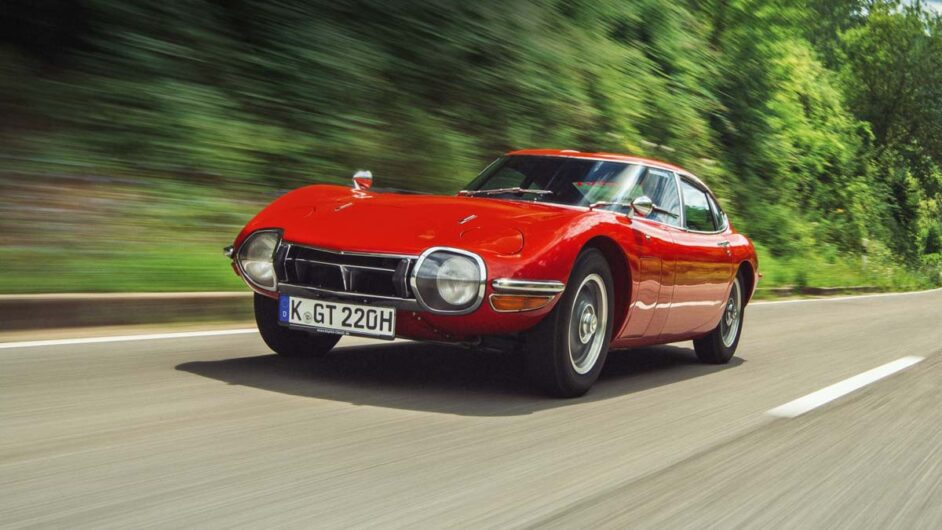
The usual to-and-fro of cornering photography gives me time to build up to the GT’s cornering attitude too, pouring the car through our chosen turn a little quicker each time. The quick steering comes into its own here, responding precisely but also sending welcome load through the rim, into your forearms and up to your shoulders. With only a lap belt holding me in, it feels natural to lean into each turn, guiding with the hands but working with the torso as the skinny 165 tyres find surprising grip from the grainy surface.
All this takes time compared with a modern equivalent, but this extended process involves you all the more. You spend longer making each gearshift, coercing each direction change and judging each braking zone, so you spend more time doing all the things that make the act of driving itself so enjoyable. There’s joy in the economy of movement of a modern sports car, but their characteristics are sometimes so focused – particularly in the age of lightning-quick dual-clutch gearchanges or tarmac-rippling brakes – that fast driving is reduced to a series of actions and commands rather than meaningful interaction between driver and machine. When we’re all forced into autonomous pods, those still fortunate enough to drive will value this interaction more than any selectable driver mode or digital display.
We’ll all, at least, still be able to appreciate the 2000GT’s beauty, however. Few cars so engaging to drive are even more enjoyable when you finally step out, sit on a rock, take in the curves and listen to warm metal ticking and clinking away. Collectors may deem Toyota’s 1960s supercar little more than a valuable commodity, but its real value is as one of the decade’s greatest sports cars.
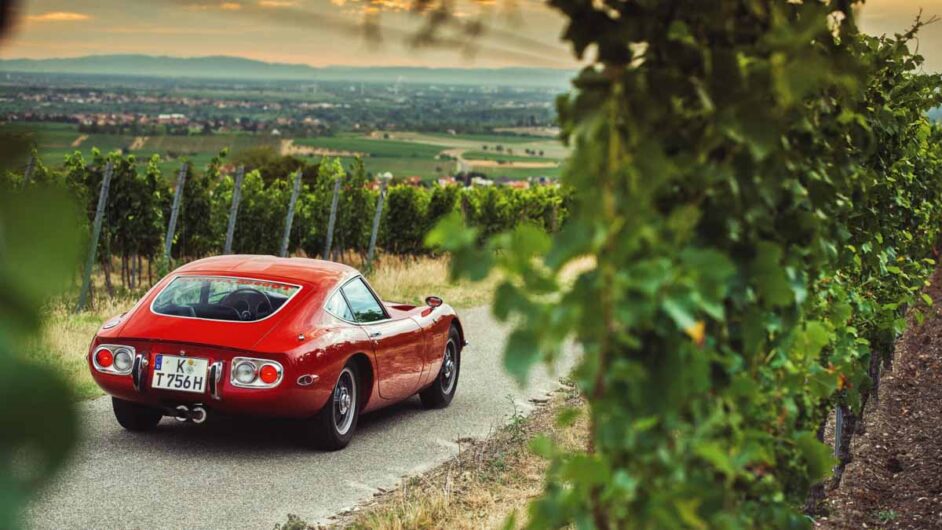
Toyota 2000GT
| Engine | In-line 6-cyl, 1988cc |
| Power | 148bhp @ 6600rpm |
| Torque | 130lb ft @ 5000rpm |
| Weight | 1120kg |
| Power-to-weight | 134bhp/ton |
| 0-100kph | 8.4sec |
| Top speed | 220kph |
| Price when new | c$3300 |
| Value today | >$522,000 |
This article originally appeared at evo.co.uk
Copyright © evo UK, Dennis Publishing




